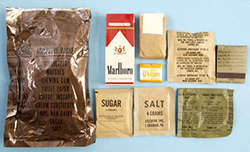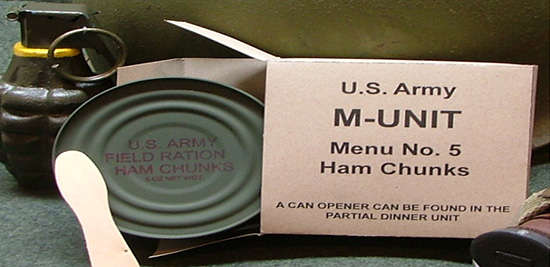Amongst the many lessons I learned in the Army was that war, on an individual basis, is nothing more than a violent game of survival. The thoughts of glory and all the other high ideals leave as soon as the bullets start flying. From then on, all you want to do is survive until your hitch is up.
While the Army doesn’t teach survival classes per se, they do teach a number of skills intended to help individual soldiers survive. They also provide a wide range of equipment and supplies with that same intention. The average soldier on the line doesn’t realize it, but officers are taught that the lives of their men are valuable and that they are to do all they can to conserve those lives, while still completing their mission.
As an officer, I received this training, but it wasn’t until years later that I realized how much effort the Army puts into ensuring the survival of their soldiers. Even the little things, like the combat rations we were issued, were designed with survival in mind.
Today, the Army issues MREs, which stands for “Meals, Ready to Eat.” Anyone who has been through boot camp will tell you that this is “three lies for the price of one.” Those were just coming in when I was going out. Back then we had C Rations, which were canned food.
Along with the cans of food was an “accessory pack” which was where the Army’s attention to detail on survival really shone through.
Coffee
 Army coffee, at least the type we had back then, has triple the caffeine of regular coffee. That’s to help the soldiers stay awake. Falling asleep on guard duty was a serious offense, one that could cost you your life in a combat zone. In combat, they slept on the buddy system, with one man sleeping, while his buddy kept guard. That way, half the unit was awake to repel any sudden attack in the night.
Army coffee, at least the type we had back then, has triple the caffeine of regular coffee. That’s to help the soldiers stay awake. Falling asleep on guard duty was a serious offense, one that could cost you your life in a combat zone. In combat, they slept on the buddy system, with one man sleeping, while his buddy kept guard. That way, half the unit was awake to repel any sudden attack in the night.
Coffee is also useful for fighting hypothermia. When someone’s body temperature starts to drop, it is imperative to raise it back up again. One of the common methods taught for this is to give them hot liquids to drink. Not only will coffee transfer heat to their body, but the caffeine will stimulate the metabolism, causing the body to generate more heat.
Chewing Gum
Like the coffee, chewing gum can help one stay awake and alert. Just the simple action of chewing is enough to keep one from dozing off. But chewing gum has another purpose in a combat situation, it’s a fairly descent way of cleaning your teeth, when you can’t brush them. Granted, it’s not as good as a toothbrush, but chewing gum will remove most of the buildup on the teeth, as well as the food between them.
Cigarettes
Okay, I know that cigarettes have been found to be a cause of lung cancer, but they were included in the C Rations, at least for a few years. Like the coffee and chewing gum, they help those on guard duty stay awake, but cigarettes teach us another lesson as well. In combat, like in prisons, cigarettes become the medium of exchange for a barter economy.
In many survival situations, bartering is a more valuable means of trade than money. If there is no way of using the money you receive, why in the world would you want it? Cigarettes, like many barter goods, can be used by the person who receives them (at least, they can if they smoke).
Matches
The simplest fire starter there is. While these were paper matches, they were chemically treated to make them waterproof. There’s nothing more useless than wet matches, when you have to start a fire. By including them in every meal, the Army ensured that soldiers always had a means of starting a fire, even if they were using some of them to light their cigarettes.
Fuel Tablets
While most survivalists collect fire starting methods like some people collect baseball cards, the Army didn’t want to count on soldiers’ ability to start a fire from what nature provided. So, in addition to providing matches, they also provided Hexamine fuel tablets. Small folding stoves for use with the heat tabs were provided as well, although they weren’t included in the C rations themselves. These would burn for several minutes, enough to heat up the C rations.
Warm food is much more comforting in a difficult situation than cold food is. While the C rations weren’t any healthier to eat warm than they were cold, being able to heat them was important for morale. Food in general is important for morale and warm food has been shown to have a more positive effect on morale than cold food.
You can still get these Hexamine fuel tablets, as well as several models of folding stoves from Esbit, a German company.
Toilet Paper
We all know that what goes in must come out, so the Army prepared for that in the C Rations. While that may not seem to be necessary for survival, it is important for morale and morale (one’s attitude) is important to survival. Including toilet paper in the C rations helped the troops feel better when they were in the field and needed it.
Toilet paper also has other uses, as it can be used as excellent tinder for starting fires. It is also useful for making bandages, when one is needed for small cuts.
Water Purification Tablets
The need for water in a survival situation cannot be overstated. But it’s not just any water that we need, we need purified water. Although the troops were expected to fill their canteens from a water buffalo (trailer) or lister bag, they were also provided with water purification tablets, as an emergency backup. Few liked to use them, as they made the water taste bad.
P-38 Can Opener
You’ve probably seen those videos of how to open a can of food by rubbing it on a cement sidewalk, just as I have. While that will work, I’d much rather use a can opener. C rations came packed with several P-38 can openers in each case. These could be shared, but most of us kept one on our dog tag chain. I’ve carried a P-38 on my key ring, ever since I went through basic training.
To me, the P-38 follows the Boy Scout rule of “be prepared.” Having one on my key chain ensures that I can always get into a can and eat its contents. I don’t need to rub it on cement or try to stab it with a knife. The P-38 is easier than both. I can’t say how many times I’ve used mine through the years.
Salt & Pepper
While salt and pepper may not seem like survival items, these tie in with the fuel tablets I mentioned above. Flavorful food is much more likely to be eaten than bland food. When one is tired and not feeling good, a little motivation to eat can’t hurt.
It’s interesting to note that in the hottest countries in the world, the food tends to be spicier. One theory that has been presented for this is that the hotter, spicier food motivates people to eat, when the high ambient temperature would otherwise reduce their desire to eat. I’m not sure if this is true, but if it is, then there’s a good survival reason to have spices in our MREs.
Of course, salt is necessary for survival anyway. Working or fighting in a hot climate will make one sweat, losing salt from their body. A ready means of replacing that salt helps to keep the person properly hydrated, as the salt is what holds water in our bodies.
Conclusion
Well, there you have it; the Army’s basic survival kit, included in every ration served to the troops. Many of these items are still supplied with the current MREs, although a few, like cigarettes, have been dropped. Those that have been retained show the timelessness of some of these survival lessons.
You may also like:
 Ingenious Foods People Made During Crisis
Ingenious Foods People Made During Crisis
The Only Food That Grows Almost Faster Than You Can Eat It (Video)
DIY TripWire Alarm Very Simple and Outrageously Loud (High Security Perimeter)
















Ciggies are a good form of bartering, even though I don’t smoke them. Being from alaska, I had to know how to stay warm, and find ways and things to barter for things like food, and warmth! Great article, as always!
I have to agree with him! He is dead on!
Frozen c-rats caused severe cramps, so you did need to heat them.
When it is below 0°F C-rations will freeze in the can. You decide at breakfast what you want for lunch and put it inside your clothing next to your undershirt. Same for dinner and breakfast the next morning. C-rations can be eaten cold. When the daytime temps never go above 0° no amount of hexamine will heat them. The best you get is body temp which is good enough. Lots of time hot coffee was brought up in big square insulated cans, otherwise you couldn’t get the water hot enough to make coffee or hot chocolate. Ate the hot chocolate like candy and washed it down. Always had to keep your canteen inside your clothing too, otherwise it froze also.
While the P-38 “John Wayne” can opener/screwdriver is a neat little piece of equipment, I prefer the P-51. I believe it was found in the old K-rations. It’s bigger to give you more leverage.
I preferred the P-38 because it was smaller.
The single best meal I remember was one made up of Beef Stew, Pound Cake, Peaches in heavy syrup, and juice. (I generally traded for tomato). As a 19 y.o. medic in 1971 I remember eating one meal and having one of the guys ask me what year I born. When I told him, he looked at the C box my meal came in an said, “You’re only 3 years older than your meal.”
What it did do was keep us fed well enough to keep putting one foot in front of the other.
Agreed, of course I was a chow-hound and liked it all. Most of of the guys in my squad, and platoon, couldn’t stand/refused to eat the Diced Ham and Lima Beans so they’d chunk it and I would ‘rescue’ it. Actually I saved a lot of food….I never went hungry!
Most of the time i heard it referred to as Ham and Mike Foxtrotters
The little packs of 4 cigarettes said, ” Warning, cigarette smoking may be hazardous to your health.” The best trading stuff was the Marlboro and Winston brand of cigarettes, the chocolate bars( there were 2 types ) and the canned peaches.
The cigarettes of my era were Camels and Lucky Strike. Occasionally there would be PallMall. No sissy filter tips. It was ten cigarettes to a tiny box. You always tapped your cigarette on your thumbnail to pack the tobacco on the end you stuck in your mouth. This kept from getting tobacco strands in your mouth when you drew on the cigarette. If you were really unlucky you got Lucky Strike Green. I suspect that there is not one reader on this list in 100 that remembers Lucky Strike Green Goes to War. The theory being that the dyes used in the red ink for the famous red circle on the pack of Luckies, was a vital war chemical and in order to make that chemical available for war production Lucky Strike printed the circle in green and Madison Avenue trotted out the slogan “Lucky Strike Green Goes to War”.
I was in the grocery store this week at the service counter and discovered that a pack of cigarettes is $10.50 in the PDRK. Gadzooks! A carton of Luckies or Camels and other standard brands cost $1.00 in the PX. Overseas in the Far East you could get the equivalent of $1.00 a pack in the black market, thus cigarettes were a good source of added income for non-smokers in the lower ranks where pay ran to $33 to $45 a month. You had ration cards that allowed you a certain number of cartons per week. This many years later I can’t remember how many cartons a week one could buy but it was a generous amount. Didn’t amount to a carton a day, I am sure. This was in the day when some nicotine addicts were never without a cigarette in their mouth, so smoking a pack a day was not an unusual habit. Some even smoked as much as 2 packs a day.
Ham and lima beans was one of my favorite meals as we had it frequently at home and it was very similar to what my mother served at home. Fruit cocktail, followed by canned peaches in heavy syrup and canned pears in heavy syrup were the all time favorites of everybody. On a hot day they were refreshingly cool and on a really cold day the high sugar content gave you an added boost of energy. One wouldn’t think eating a cold can of fruit would actually warm you but it did. You could be shivering from the cold and a can of cold peaches would soon stop the shivering.
The one big improvement today over those days is the Leatherman. What I wouldn’t have given in those days to have the convenience of even the first Leatherman. What a marvelous invention. Today I would rather go out without my trousers on than leave the house without my Leatherman. Tim Leatherman certainly did the world, and especially the guy in uniform a great service when he invented his tool. When my brother left for Vietnam, I originally was going to give him a Ka-Bar, even though he was in the Army, but decided instead that a Swiss Army Knife would be more useful. He would be issued a bayonet and while the newer, smaller bayonet was okay, nothing was a more all around tool than the old WWII 11 inch bayonet. It would open a can of C-rations very easily. Two of them could pry the lock off a foot locker or wall locker. With a rock one could drive the blade through almost anything without damage to the blade. Anyway, my brother told me that having the Swiss Army Knife was the handiest thing he had while in the rice paddies in the Delta. Unfortunately, part way through his tour it disappeared. I didn’t know that or I would have sent him a replacement as they were not available in the PX system in Vietnam. Today, the departure gift would be a Leatherman.